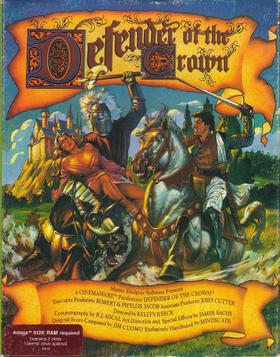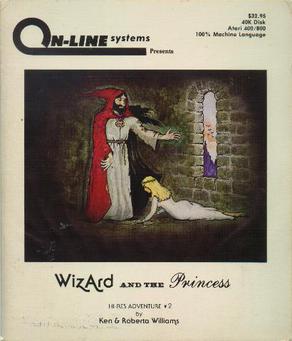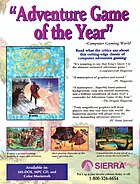Mark Seibert is an American musician, composer, and producer best known for his work on various video games from Sierra Entertainment.

King's Quest is a graphic adventure game series, released between 1980 and 2016 and created by the American software company Sierra Entertainment. It is widely considered a classic series from the golden era of adventure games. Following the success of its first installments, the series was primarily responsible for building the reputation of Sierra. Roberta Williams, co-founder and former co-owner of Sierra, designed all of the King's Quest games until the series' reboot in 2015.

Roberta Lynn Williams is an American video game designer and writer, who co-founded Sierra On-Line with her husband, game developer Ken Williams. In 1980, her first game, Mystery House, became a modest commercial success; it is credited as the first graphic adventure game. She is also known for creating and maintaining the King's Quest series, as well as designing the full motion video game Phantasmagoria in 1995.

Defender of the Crown is a strategy video game designed by Kellyn Beeck. It was Cinemaware's first game, and was originally released for the Commodore Amiga in 1986, setting a new standard for graphic quality in home computer games.

Conquests of Camelot: The Search for the Grail is a graphic adventure game released in 1990 by Sierra On-Line. It was the first game in the Conquests series designed by Christy Marx and her husband Peter Ledger. The only other game in the series was 1991's Conquests of the Longbow: The Legend of Robin Hood. Marx did the majority of the design work while Ledger created the game and package art.

King's Quest: Quest for the Crown is an adventure game developed by Sierra On-Line and published originally for the IBM PCjr in 1984 and later for several other systems between 1984 and 1989. The game was originally titled King's Quest; the subtitle was added to the games box art in the 1987 re-release, but did not appear in the game.

King's Quest II: Romancing the Throne is the second installment in the King's Quest series of graphic adventure games by Sierra On-Line. It was originally released in 1985 for PC DOS/PCjr, and later made available for the Apple II/IIGS, Atari ST, and Amiga. It uses the same AGI game engine as King's Quest I: Quest for the Crown and features King Graham as the player character. The title is a spoof of the 1984 film Romancing the Stone.

King's Quest III: To Heir Is Human is the third installment in the King's Quest series of graphic adventure games developed and released by Sierra On-Line in 1986. The game was originally released for the Apple II and PC DOS, and later ported to several other computer systems. It was the first title game in the series not to feature King Graham as the player character.

King's Quest IV: The Perils of Rosella is a graphic adventure game developed and released by Sierra On-Line for the MS-DOS, Amiga, Apple II, Apple IIGS, and Atari ST computers in 1988. The player takes on the role of Princess Rosella, daughter of King Graham of Daventry and the twin sister of Gwydion/Alexander, who must save her father and a good fairy and destroy an evil witch. Critically acclaimed, it was one of the first PC games to support a sound card.

King's Quest VI: Heir Today, Gone Tomorrow is a point-and-click adventure game, first released in 1992 as the sixth installment in the King's Quest series produced by Sierra On-Line. Written by Roberta Williams and Jane Jensen, King's Quest VI is widely recognized as the high point in the series for its landmark 3D graphic introduction movie and professional voice acting. King's Quest VI was programmed in Sierra's Creative Interpreter and was the last King's Quest game to be released on floppy disk. A CD-ROM version of the game was released in 1993, including more character voices, a slightly different opening movie and more detailed artwork and animation.

Roberta Williams' Mixed-Up Mother Goose is a computer game first released by Sierra On-Line in 1987. It is, in essence, an edutainment title, directed specifically at young gamers, as well as an adventure game. It was the first multimedia game released on CD-ROM in 1991. A second game in the series, Mixed-Up Fairy Tales, was released in 1991.

Quest for Glory: So You Want to Be a Hero is a 1989 adventure game/role-playing game hybrid, designed by Lori Ann Cole and published by Sierra On-Line for MS-DOS. It is the first game in the Quest for Glory series, and has been credited for being a genre-defining game, as it tried to mix graphical adventure gaming with role-playing-like elements such as statistic building that would actually affect the ability to accomplish certain parts of the game. The game has a satirical and silly tone. Ports for the Amiga, Atari ST, and NEC PC-9801 were released in the early 1990s. A VGA remake, titled Quest for Glory I: So You Want to Be a Hero, was released in 1992 for DOS and later in 1994 for Mac OS.

Space Quest: Chapter I – The Sarien Encounter is a graphic adventure game, created by Scott Murphy and Mark Crowe, and released in October 1986 by Sierra On-Line. It is the first game in the Space Quest series, and sees players assume the role of a lowly janitor on a research ship, who becomes involved in stopping an alien race using a new form of technology for evil purposes.

Space Quest IV: Roger Wilco and the Time Rippers is a 1991 graphic adventure game by Sierra On-Line, and the fourth entry in the Space Quest series. The game was released originally on floppy disks on March 4, 1991, and later released on CD-ROM in December 1992 with full speech support; an Atari ST version was announced via Sierra Online's magazine, Sierra News Magazine, but was later canceled. The game sees players assume the role of Roger Wilco, who is thrust into a new adventure across time and space where he must thwart the plans of an old foe that is seeking revenge against him.

Space Quest III: The Pirates of Pestulon is a 1989 graphic adventure game by Sierra On-Line, and the third game in the Space Quest series. Players assume the role of Roger Wilco, a lowly space janitor, who becomes involved in rescuing a pair of computer programmers from a sinister video game company. The game received positive reviews from critics, and contributed further to the series' commercial success for Sierra. A sequel, Space Quest IV, was released in 1991.
Infamous Adventures is an amateur game development company, founded in 2004 by Shawn Mills and Steven Alexander, and is dedicated to making games in the classic adventure style made famous by the releases of Sierra Entertainment and LucasArts in the 1980s and early 1990s.

Wizard and the Princess is a graphic adventure game written for the Apple II and published in 1980 by On-Line Systems. It was the second title released in the Hi-Res Adventures series after Mystery House. While Mystery House used monochrome drawings, Wizard and the Princess added color. Ports for the Atari 8-bit family and Commodore 64 were released in 1982 and 1984 respectively. The 1982 self-booting version for IBM PC compatibles was renamed Adventure in Serenia.
King's Quest II: Romancing the Stones is a fangame reimagining/retelling of Sierra Entertainment's King's Quest II: Romancing the Throne by AGD Interactive produced through a fan license by Sierra Entertainment. It was followed up by King's Quest III: To Heir Is Human. In 2009, the version 3.0 Enhanced Edition was released, with improved graphics and full-speech narration. The game earned the AGS award for best music and game in 2002.
King's Quest III: To Heir is Human is a VGA-style fangame remake/reimagining/retelling of Sierra Entertainment's King's Quest III: To Heir Is Human by Infamous Adventures. It was released on June 19, 2006. A slightly expanded remake offers new material including; new cutscenes, a few new characters, expanded narration or dialogue, additions and changes to some of the plot, full speech, new or modified locations, and Easter eggs. Most of the original puzzles remain intact or item placement changed. The game received the AGS reward for best documentation in 2006.
There have been several King's Quest fangames both original and retellings/remakes of the original games that have been released by various developers.


















